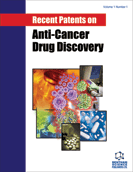Abstract
The matrix metalloproteinases (MMPs), belonging to the family of proteolytic enzymes, are well-known for their ability to degrade the extracellular matrix, and are involved in many aspects of both physiological cellular processes and pathological situations, such as tumor growth, invasion and metastasis. MMPs have been considered prognostic factors in various types of cancer as well as promising targets for cancer therapy. Although preclinical studies of a number of different synthetic MMP inhibitors have been identified as cytostatic and anti-angiogenic agents and have begun clinical testing, the past years have produced a consistent number of disappointments and limited successes. In view of their specific implication in malignant tissues, several natural compounds were utilized, and the results were so satisfactory as to encourage several clinical trials in order to improve efficacy and to reduce the side effect profile. The natural protection against cancer has been receiving a great deal of attention, and the critical examination of previous studies shed light on new information about the source and function of MMPs, focusing the attention on the identification of MMP targets in tumors. This review discusses the current knowledge and research in the field of natural MMP inhibitor as innovative therapeutic intervention in cancer.
Keywords: Biodrugs, Cancer, Clinical Trials, Gelatinases, Matrix Metalloproteinases, Natural Compounds, Nutraceuticals, Protease Inhibitors, Therapeutic strategies
Recent Patents on Anti-Cancer Drug Discovery
Title: Natural Bio-Drugs as Matrix Metalloproteinase Inhibitors: New Perspectives on the Horizon?
Volume: 1 Issue: 1
Author(s): Ferdinando Mannello
Affiliation:
Keywords: Biodrugs, Cancer, Clinical Trials, Gelatinases, Matrix Metalloproteinases, Natural Compounds, Nutraceuticals, Protease Inhibitors, Therapeutic strategies
Abstract: The matrix metalloproteinases (MMPs), belonging to the family of proteolytic enzymes, are well-known for their ability to degrade the extracellular matrix, and are involved in many aspects of both physiological cellular processes and pathological situations, such as tumor growth, invasion and metastasis. MMPs have been considered prognostic factors in various types of cancer as well as promising targets for cancer therapy. Although preclinical studies of a number of different synthetic MMP inhibitors have been identified as cytostatic and anti-angiogenic agents and have begun clinical testing, the past years have produced a consistent number of disappointments and limited successes. In view of their specific implication in malignant tissues, several natural compounds were utilized, and the results were so satisfactory as to encourage several clinical trials in order to improve efficacy and to reduce the side effect profile. The natural protection against cancer has been receiving a great deal of attention, and the critical examination of previous studies shed light on new information about the source and function of MMPs, focusing the attention on the identification of MMP targets in tumors. This review discusses the current knowledge and research in the field of natural MMP inhibitor as innovative therapeutic intervention in cancer.
Export Options
About this article
Cite this article as:
Mannello Ferdinando, Natural Bio-Drugs as Matrix Metalloproteinase Inhibitors: New Perspectives on the Horizon?, Recent Patents on Anti-Cancer Drug Discovery 2006; 1 (1) . https://dx.doi.org/10.2174/157489206775246421
| DOI https://dx.doi.org/10.2174/157489206775246421 |
Print ISSN 1574-8928 |
| Publisher Name Bentham Science Publisher |
Online ISSN 2212-3970 |
Related Books
 37
37
- Author Guidelines
- Bentham Author Support Services (BASS)
- Graphical Abstracts
- Fabricating and Stating False Information
- Research Misconduct
- Post Publication Discussions and Corrections
- Publishing Ethics and Rectitude
- Increase Visibility of Your Article
- Archiving Policies
- Peer Review Workflow
- Order Your Article Before Print
- Promote Your Article
- Manuscript Transfer Facility
- Editorial Policies
- Allegations from Whistleblowers
Related Articles
-
Cadmium-containing Quantum Dots: Current Perspectives on Their Application as Nanomedicine and Toxicity Concerns
Mini-Reviews in Medicinal Chemistry Epidermal Growth Factor Receptor (EGFR) Tyrosine Kinase Inhibitors from the Natural Origin: A Recent Perspective
Anti-Cancer Agents in Medicinal Chemistry Radiolabelled Probes Targeting Tumor Hypoxia for Personalized Medicine
Current Pharmaceutical Design 64Cu Labeled AmBaSar-RGD2 for micro-PET Imaging of Integrin αvβ3 Expression
Current Radiopharmaceuticals Heme Oxygenase-1 in Tumor Biology and Therapy
Current Drug Targets Synthetic and Biological Aspects of Thiadiazoles and their Condensed Derivatives: An Overview
Current Topics in Medicinal Chemistry Dynamic Contrast-Enhanced MRI in Oncology Drug Development
Current Clinical Pharmacology Perfusion Computed Tomography and its Application in Oncologic Practice
Current Molecular Imaging (Discontinued) Differences in Phosphorylated Histone H2AX Foci Formation and Removal of Cells Exposed to Low and High Linear Energy Transfer Radiation
Current Genomics Tritiated Opioid Receptor Ligands as Radiotracers
Current Pharmaceutical Design The Radiosensitizing Effect of Olanzapine as an Antipsychotic Medication on Glioblastoma Cell
Current Radiopharmaceuticals Investigation of in Vitro Release Dynamics of Cisplatin from Genipin Crosslinked Gelatin Nanocarriers
Drug Delivery Letters Threes Company: Regulation of Cell Fate by Statins
Current Drug Targets - Cardiovascular & Hematological Disorders ADAMTS9-AS2: A Functional Long Non-coding RNA in Tumorigenesis
Current Pharmaceutical Design Polyphenols and Neuroprotection against Ischemia and Neurodegeneration
Mini-Reviews in Medicinal Chemistry PI-3 Kinase-PTEN Signaling Node: An Intercept Point for the Control of Angiogenesis
Current Pharmaceutical Design Overview of Molecular Signal Transduction of Malignant Gliomas and Correlation with Responses to Targeted Therapy Recent advances in Molecular Characterization of Glioblastoma
Current Signal Transduction Therapy Lipid based Nanocapsules: A Multitude of Biomedical Applications
Current Pharmaceutical Biotechnology Kernelized Convex Hull based Collaborative Representation for Tumor Classification
Current Proteomics Interactions Between Cholinergic and Fibroblast Growth Factor Receptors in Brain Trophism and Plasticity
Current Protein & Peptide Science


























